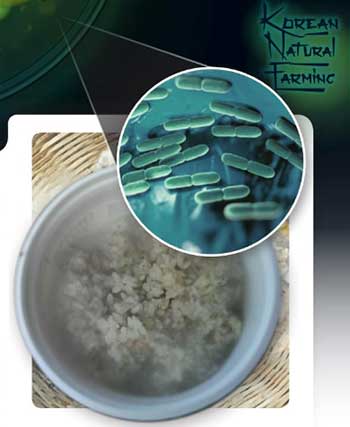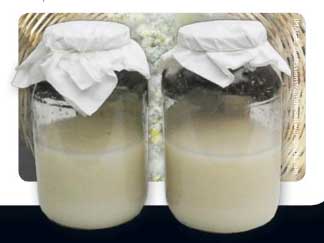This article was originally published in Garden Culture Magazine US22 and UK25.
That’s right, dearest reader; it’s time for the latest installment of how to make your own organic growing inputs, courtesy of Korean Natural Farming practices. Ditch the bottles, make your own inputs and feel like a complete boss while you’re doing it.
It’s the little things in life that count: something I constantly re-iterate to my loving wife. Like some sort of defensive mantra that is definitely in no way linked to the size of my manhood, the quality of any one particular thing in life is always of much more importance than its quantity. The Flight of the Conchords say, “two minutes in heaven is better than no minutes in heaven”. Sure, bigger things may initially seem more gratifying to our inherently greedy human brains, but I’d much rather a small amount of something perfect, than a huge load of something satisfactory.
What I’m trying to convey is just how important small things are, especially when talking about bacteria. In a similar fashion to their fungal friends, they play a wide variety of roles in plant growth and are particularly crucial when growing in an organic setting. Soil life thrives with healthy and diverse biology, so it is crucial that you almost pay more attention to promoting the health of your soil biology than you do the actual plants growing in it. One particular type of beneficial bacteria that you can easily culture from the natural world is Lactic Acid Bacteria (LAB), which will be the focus of our attention for the next few pages.
What exactly are LAB’s?
Lactic Acid Bacteria (LAB) are a particularly interesting group of bacteria that are one of the key components of a full-blown KNF regime. Why are they particularly interesting, I hear you ask? Well, they are one of the few groups of bacteria that are capable of functioning in both aerobic and anaerobic conditions. “Anaerobic bacteria?” I hear you cry, “What the crikey-fuck do you want them for? That’s root disease territory isn’t it?” Well, yes, the majority of root diseases are anaerobic pathogens, but these bacteria are cut from an entirely different cloth, my friend.
This particular group of bacteria (as the name would suggest) produce lactic acid as a by-product of their digestive process. LAB are extremely widespread in nature, found pretty much everywhere in the environment, hence why capturing and culturing them is actually quite an easy and fun process. This is also one of the first steps in making your own cheese.
What do they even bloody do?

There are a few ways in which making use of LAB can benefit your grow. You don’t even have to go the whole hog on the organic regime front either; you can integrate it quite easily into pretty much any style of growing. One of the first things they do is simply populate space in your media. This might sound a bit boring and of no significance, but by populating free space in your media, they will be preventing harmful pathogens from ever making their way in. Similar to how bouncers at a club turn away groups of drunken men without any women with them, but probably with a higher IQ.
But wait – there’s more! Not only do they help to out-populate bad bacteria, they also help to break down organic nutrients locked away in those pesky organic carbon complexes within your media. The decomposition of organic matter/amendments is greatly increased within the media when you apply a LAB serum, meaning a much greater availability of nutrients for absorption by the plants. For this reason, they are a fantastic addition when you are making your own compost or compost teas, as they will help to greatly increase the availability of all of that lovely organic nutrient. It’s kind of like little knives and forks going around and cutting up all the food on the plate ready for the plant to eat.
One thing to potentially look out for when you are using LAB culture, particularly with fruiting plants, is that you slow down with the application rate towards the end of the flowering cycle. This is just to ensure that you are not over-applying LAB’s, as in certain circumstances, over application can actually cause a response in the plant that will lower the Brix levels in your fruits. This obviously results in a slight loss of sweetness in the overall flavor of your fruit, something to be avoided if at all possible.
How exactly do you make it?
You will need:
- Rice
- Water
- Container
- Milk
- Strainer
- Sugar (optional)
Essentially, what you are doing here is making curds and whey. Miss Muffet would probably love to get her hands on such freshly-prepared dairy produce.
-
Wash your rice in some water. Just like you would if you were normally making rice, but rather than discarding the water, pour it into a container to about two thirds full.
-
Cover the container with a breathable lid. Store in a cool, dry, and dark place, moving it as little as possible.
-
Wait three to five days. You will know when it is done as the smell of the liquid will become slightly sweet. This means that the LAB has cultured correctly in the solution. If you see any weird-looking bacteria growing on the surface during this time, discard and start again.
-
Try to collect the middle layer of the solution. There will be a slightly thicker layer at the top of the liquid, which ideally you do not want to collect. Focus on the layer directly underneath this.
-
Add 1-part cultured rice wash to 10 parts of your milk. Ideally, do not do this with milk that is either pasteurized (because of the antibiotics) or straight out of the fridge (slows the process down slightly). Once again, store in a cool, dry, and dark place.
-
After three to five days (longer when temperatures are cooler), you will see that the solution has totally separated into curds and whey. The curds will be at the top and the yellow whey serum at the bottom. The yellow liquid is the LAB culture.
-
Separate the solids from the liquids. This involves a quick straining through an appropriate implement. There will be a little layer of solids at the bottom as well; try to avoid collecting these in your final solution.
-
Put LAB liquid into a container and store in a fridge for use. Use at 1 mL per liter once a week until the mid-flower period. If you want to make it for long-term storage, add equal weight brown sugar to the liquid.

Jobs a good’un
So, that is basically it. You now are the proud owner of some LAB serum that is perfect for immediate use as a root drench, or just as good to use in a compost tea brew. It also makes a great addition to a compost pile, helping to process the waste into a rich material much faster than it would usually take.
Like most KNF inputs, you can use this as a one-off additive, even if you aren’t growing in a typical organic environment. For example, if you are a coco/hydroponic grower, you can inoculate your media at 1 mL per liter to get all the benefits of Lactic Acid Bacteria, without changing anything else about your particular methods.
Anyway, just remember the next time you are making some rice, that wastewater from the rinse could be put to much better use than simply pouring down your sink.
Want more KNF? Be sure to check out our other articles in this series:
- A Guide to Korean Natural Farming
- Korean Natural Farming: Master Cho Biography
- Korean Natural Farming and Indigenous Microorganisms
- Korean Natural Farming: Feed Ferment To Your Plants
- Korean Natural Farming: DIY Organic Growing Inputs
- The Fundamentalists of Korean Natural Farming
- Korean Natural Farming: DIY Water-Soluble Organic Nutrients
- Korean Natural Farming: DIY Herbal Remedy For Plants
- Merging Hydroponics With Organics In Korean Natural Farming
Pasteurization of milk doesn’t involve antibiotics.
good